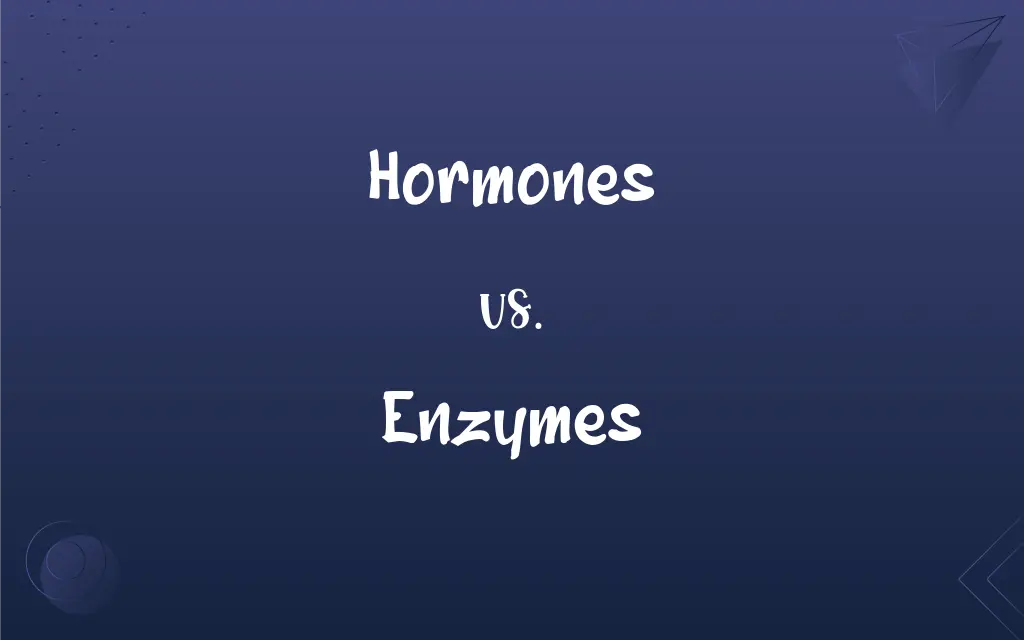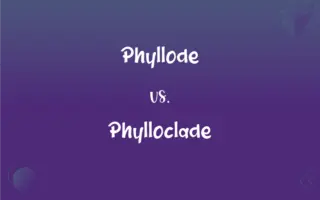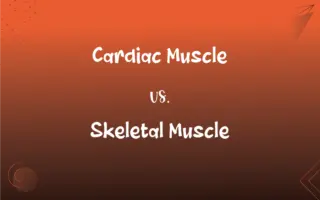Hormones vs. Enzymes: What's the Difference?
Edited by Janet White || By Harlon Moss || Updated on October 29, 2023
Hormones are chemical messengers regulating body functions, while enzymes are proteins that catalyze biochemical reactions.

Key Differences
Hormones and enzymes are vital biological molecules that play critical roles in the functioning of living organisms. Hormones act as messengers, typically produced by glands in the endocrine system, and regulate various physiological processes by traveling through the bloodstream to target organs or tissues. Enzymes, in contrast, are catalysts that speed up chemical reactions in cells. While hormones convey signals to regulate body functions, enzymes facilitate the reactions required for those functions.
The nature and composition of hormones and enzymes differ. Hormones can be proteins, steroids, or derivatives of amino acids. They function by binding to specific receptors, often triggering a cascade of events within cells, leading to a particular response. Enzymes, on the other hand, are predominantly proteins that bind to specific substrates, converting them into products. While hormones elicit responses by initiating cellular events, enzymes ensure that reactions proceed fast enough to be biologically useful.
When considering the scope and longevity of their actions, hormones and enzymes show distinct characteristics. Hormones, when secreted, can exert effects on distant cells or organs, often having widespread and lasting impacts. Their actions can range from triggering growth and development to managing stress and regulating metabolism. Enzymes, however, typically act locally and instantaneously, catalyzing specific reactions where they are located. While hormones command or regulate processes, enzymes execute them.
The regulatory mechanisms for hormones and enzymes also differ. Hormone release is often influenced by factors such as feedback mechanisms, where the levels of certain substances or conditions in the body determine hormone secretion. Enzymes, conversely, are regulated by factors like temperature, pH, and the presence of specific molecules that can enhance or inhibit their activity. Both hormones and enzymes exhibit precise control, but while hormones are often part of intricate feedback loops, enzymes react to immediate environmental conditions.
In essence, both hormones and enzymes are indispensable for life. Hormones function as internal messengers, coordinating various physiological processes and ensuring the body responds appropriately to internal and external changes. Enzymes, with their catalytic nature, ensure that the biochemical reactions vital for life occur efficiently and effectively. Together, hormones and enzymes harmoniously orchestrate the intricate symphony of life processes.
ADVERTISEMENT
Comparison Chart
Function
Chemical messengers
Biological catalysts
Location of Action
Often act distantly
Act locally
Composition
Proteins, peptides, steroids
Always proteins
Role in Body
Regulate body functions
Catalyze biochemical reactions
Speed & Duration of Effect
Slower, longer-lasting
Quick, short-term
ADVERTISEMENT
Hormones and Enzymes Definitions
Hormones
Hormones are crucial for growth.
Growth hormone influences physical development.
Enzymes
Enzymes are proteins.
The enzyme pepsin aids in protein digestion.
Hormones
Hormones regulate bodily functions.
Thyroid hormones control metabolism.
Enzymes
Enzymes act as biological catalysts.
Amylase, an enzyme, breaks down starch into sugar.
Hormones
Produced by endocrine glands.
Adrenal glands secrete the hormone cortisol.
Enzymes
Enzymes have specific action sites.
DNA polymerase enzymes are crucial in DNA replication.
Hormones
Hormones act as chemical messengers.
Insulin, a hormone, regulates blood sugar levels.
Enzymes
Enzymes accelerate biochemical reactions.
Lactase enzyme speeds up lactose digestion.
Hormones
They regulate reproduction.
Estrogen, a hormone, plays a key role in female reproductive health.
Enzymes
Found throughout the body's cells.
Enzymes in mitochondria are vital for energy production.
Enzymes
Any of numerous compounds that are produced by living organisms and function as biochemical catalysts. Some enzymes are simple proteins, and others consist of a protein linked to one or more nonprotein groups.
Enzymes
Plural of enzyme
FAQs
What do enzymes do?
Enzymes catalyze and speed up biochemical reactions.
Can enzymes be inhibited?
Yes, enzymes can be inhibited by various substances.
Are enzymes found in all cells?
Yes, enzymes are present in all types of cells.
Do enzymes work on specific substances?
Yes, enzymes typically act on specific substrates.
What happens when enzymes malfunction?
Malfunctioning enzymes can lead to metabolic disorders.
Can hormones affect emotions?
Yes, hormones like serotonin can influence mood and emotions.
Can enzymes be reused?
Yes, enzymes can be reused in multiple reactions.
Do hormones play a role in growth?
Yes, hormones like growth hormone are essential for growth.
Are all enzymes proteins?
Yes, all enzymes are proteins.
Can hormone levels fluctuate?
Yes, hormone levels can fluctuate due to various factors.
Are hormones only found in humans?
No, hormones are found in all multicellular organisms.
Do hormones have immediate effects?
Hormones usually have slower but longer-lasting effects.
Where are hormones produced?
Hormones are produced by endocrine glands.
Do hormones directly catalyze reactions?
No, hormones act as messengers and don't catalyze reactions directly.
How quickly do enzymes work?
Enzymes work quickly to catalyze reactions.
Are all hormones proteins?
No, hormones can be proteins, peptides, or steroids.
How are hormones transported?
Hormones are transported through the bloodstream.
Can enzymes regulate body functions?
Enzymes catalyze reactions but don't directly regulate body functions.
What are hormones?
Hormones are chemical messengers regulating various body functions.
Do enzymes have a long-term effect?
Enzymes have immediate but generally not long-term effects.
About Author
Written by
Harlon MossHarlon is a seasoned quality moderator and accomplished content writer for Difference Wiki. An alumnus of the prestigious University of California, he earned his degree in Computer Science. Leveraging his academic background, Harlon brings a meticulous and informed perspective to his work, ensuring content accuracy and excellence.
Edited by
Janet WhiteJanet White has been an esteemed writer and blogger for Difference Wiki. Holding a Master's degree in Science and Medical Journalism from the prestigious Boston University, she has consistently demonstrated her expertise and passion for her field. When she's not immersed in her work, Janet relishes her time exercising, delving into a good book, and cherishing moments with friends and family.































































